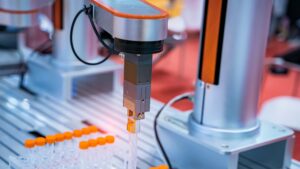15/10/2024
This year’s Nobel Prize in Chemistry celebrates groundbreaking work in the world of proteins—nature’s molecular machines. The 2024 laureates have pioneered techniques that allow for precise control over protein structures and functions. Their work has the potential to reshape our understanding of biological processes and open new avenues for innovation across multiple scientific disciplines.
David Baker, from the University of Washington, was awarded one half of the prize for his research in computational protein design. His model – which combines Rosetta software, machine learning and experimental validation – enables the design of entirely new proteins with specific functions. This could revolutionise drug development, synthetic biology and nanotechnology, and open up possibilities for new medical treatments, vaccines, nanomaterials and sensors.
The other half of the prize was shared by Demis Hassabis and John Jumper, both from Google DeepMind, for their work on developing the AI model AlphaFold2. AlphaFold2 can predict the three-dimensional structure of nearly every known protein from its amino acid sequence – a task that had been considered impossible for several decades.
Before AlphaFold, determining 3D protein structures was a complex and time-consuming task, often requiring experimental methods such as X-ray crystallography and cryo-electron microscopy. AlphaFold simplifies this process through deep learning algorithms that analyse vast amounts of biological data, enabling it to predict protein structures rapidly and accurately. Since its launch, AlphaFold has accurately predicted the structures of over 200 million proteins, and has been used by more than 2 million researchers globally. Its applications range from visualising enzymes that can decompose plastics to helping researchers explore complex biological processes more efficiently.
Whilst DeepMind has made AlphaFold2’s code open-source, allowing for widespread use and collaboration, its underlying methods are protected through patents. DeepMind filed three international (PCT) applications in 2019 which cover relatively broad methods of generating multiple structural predictions, updating parameters using neural networks, and selecting the final structure.
Additionally, some aspects of AlphaFold2 may be kept as trade secrets. Unlike patents, which require public disclosure of the invention, trade secrets remain private which can be advantageous in certain scenarios. In the case of AlphaFold2, although much of the system is public, certain details about the algorithms, neural network architecture, or data handling processes could be kept confidential. In many areas of technology, companies will often use a clever blend of patents and trade secrets to maximise protection for their innovations.
This is the first time a Nobel prize has been awarded for an AI-enabled scientific breakthrough, and it probably won’t be the last. As the life sciences field increasingly relies on AI-driven discoveries, companies in that space will need to carefully consider how to obtain meaningful protection for both the AI platforms and the products generated by such platforms.
If you would like to learn more about maximising intellectual property protection in this exciting and emerging field, then patent and trademark attorney experts at Reddie & Grose are here to assist.
This content is for general information only. Its content is not a statement of the law on any subject and does not constitute advice. Please contact Reddie & Grose LLP for advice before taking any action in reliance on it.



